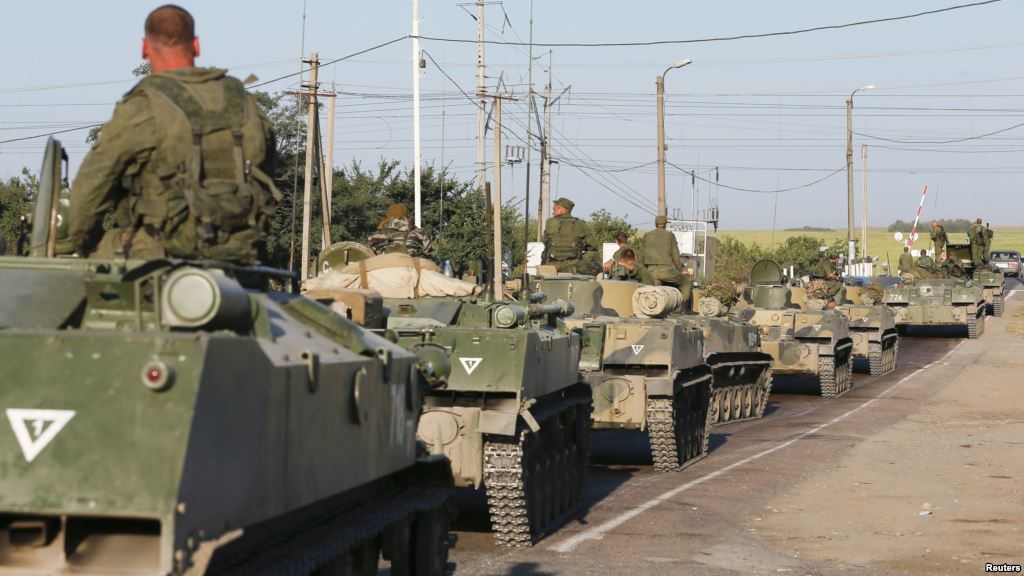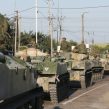
Russian Military Reform: The Ukraine Conflict and Its Impact on Morale
Publication: Eurasia Daily Monitor Volume: 12 Issue: 136
By:

Evidence has emerged in Russia’s Southern Military District (MD) that the conflict in Ukraine is not popular among Russian contract personnel (kontraktniki). Reportedly “dozens” of kontraktniki have absconded from or deserted their units on grounds of their opposition to being sent to fight in Donbas. After more than a year of the Kremlin-spun official line that there are no Russian troops fighting in southeastern Ukraine, paradoxically the most striking evidence to the contrary is from a garrison tribunal in Maykop, in which Russian soldiers are being prosecuted for absconding from their unit or for desertion. These men face penalties of up to five to ten years in prison (Gazeta.ru, July 10).
The cases involve military personnel accused of absconding or desertion from military unit 22179 of the 33rd Motorized Rifle Brigade in Maykop. The personnel, all kontraktniki, were taken to the Kadamovskiy training ground in Rostov Region in Southern MD, from where they refused to be sent to the conflict in Ukraine. As one of the accused stated, “I did not want to participate in combat operations on Ukrainian territory.” According to official statistics from the Maykop Garrison Tribunal, in the first half of 2015 there were 62 rulings issued under Section 4 of Article 337 of the Russian Criminal code (absconding from a unit), compared with a total of 35 cases in the period 2010–2014 (Gazeta.ru, July 10). These cases revolve around the unpopularity of being sent to fight in Donbas and the conditions of service and treatment experienced at the training ground in Rostov Region.
Aleksandr Golts assessed the implications of the kontraktniki desertions in Yezhednevny Zhurnal, concluding that the Serdyukov-era reforms (2008-2012, initiated by former Russian defense minister Anatoly Serdyukov) are rapidly disintegrating. Golts based his conclusion on the shocking conditions experienced by the deserters and highlighted the fact that this is occurring among contract personnel rather than the conscripts. He noted that after years of reform, the quality of contract servicemen has not advanced much, and their terms and benefits of service appear exaggerated. Golts also noted the mistreatment or lack of care for subordinates on the part of Russian officers and left no doubt that the conflict in Ukraine is taking its toll on the Russian Army (Yezhednevny Zhurnal, July 13).
According to the accused and some accounts by those convicted through the garrison tribunal, the kontraktniki experienced harsh conditions at Kadamovskiy training ground, with bedding in the form of a blanket thrown on the ground; at least one soldier returned from Kadamovskiy suffering from pneumonia. Aleksandr Yenenko, a 22-year-old junior sergeant described his experience of the training ground, saying that personnel spent days “pointlessly digging pits and immediately filling them in again. They [officers] told them [kontraktniki] that they wanted to send them to Ukraine, and they waited about a week for the order to cross the border, but at the last moment they canceled it.” Yenenko says that he also saw “some guys in camouflage gear without identification badges exhorting people to fight in Donbas for money.” Another contract soldier added, “It was late October, there were frosts at night, and everybody had a terrible cough. We would buy firewood at our own expense and light a bonfire by what passed for a tent. The hardest thing was the lack of water; they would bring in one truck for the kitchen and allow only one cup of tea a day. Locals would come and sell us a bottle of mineral water for 100 rubles each [in October 2014, approximately $2.40]” (Gazeta.ru, July 10).
While Golts highlights the serious implications concerning the link between the AWOL kontraktniki and the results of military reform, there are also important issues revealed as a result of such reporting. Golts notes that the military reform of 2008 to 2012 was aimed at improving combat capabilities and readiness in order to achieve rapid victory in future conflicts; it was not designed to sustain the type of conflict experienced in Donbas. Yet, it is equally crucial to note the unpopularity of the conflict among Russian contract personnel. The mother of Ivan Shevkunov, a 20-year-old contract soldier in the Maykop brigade, told Ekho Moskvy that her son submitted a resignation letter three times as he did not want to fight in Ukraine, but his applications were denied (Ekho Moskvy, July 11). Moreover, the reporting of the cases offers insight into how “volunteers” are “recruited” from Russian Army units and sent across the border to fight alongside separatist forces. It shows exactly how units are broken up and prepared for deployment in Ukraine in addition to the role of Russian officers in this process (Novaya Gazeta, July 14).
The movement of troops from the base in Maykop to the training ground in Rostov Region may serve as a model for how the Russian Army moves and prepares troops for deployment in southeastern Ukraine. According to the various accounts offered by these kontraktniki, the following pattern emerges: First, troops receive legitimate orders to move out of their base and go to Kadamovskiy training ground. Sometime after arrival, “agitators” appear at the training ground tasked with recruiting volunteers to fight in Ukraine. These agitators are described as anonymous, dressed in camouflage with no insignia, only shoulder boards, thus identifying them as officers. Since they are unknown to the soldiers, it is clear they are not unit commanders. They make no appeal to Russian patriotism or nationalism. Rather, they appear to use bullying methods and offer near-ludicrous incentives to those persuaded to volunteer. The offer is 8,000 rubles ($142) per day plus veteran status on their return to Russia; according to some of those who accepted the offer, the money is never paid. Surprisingly, the kontraktniki say there are also separatists billeted at the Rostov training ground, which may indicate an early effort to mix such forces (Gazeta.ru, July 10).
Beneath the surface of Russia’s so-called “hybrid warfare” lies an ugly set of lies, deceit and, effectively, a make-shift approach to deconstruct and reconstruct military units. This method of conducting warfare will certainly not prove popular among either officers or enlisted personnel. Although these accounts provide a glimpse into how Russian units are deployed in Donbas, it is still unclear how the units are reassembled once across the border, whether unit commanders then arrive and reconnect with their units, or precisely how newly assembled units of “volunteers” function in combat.




